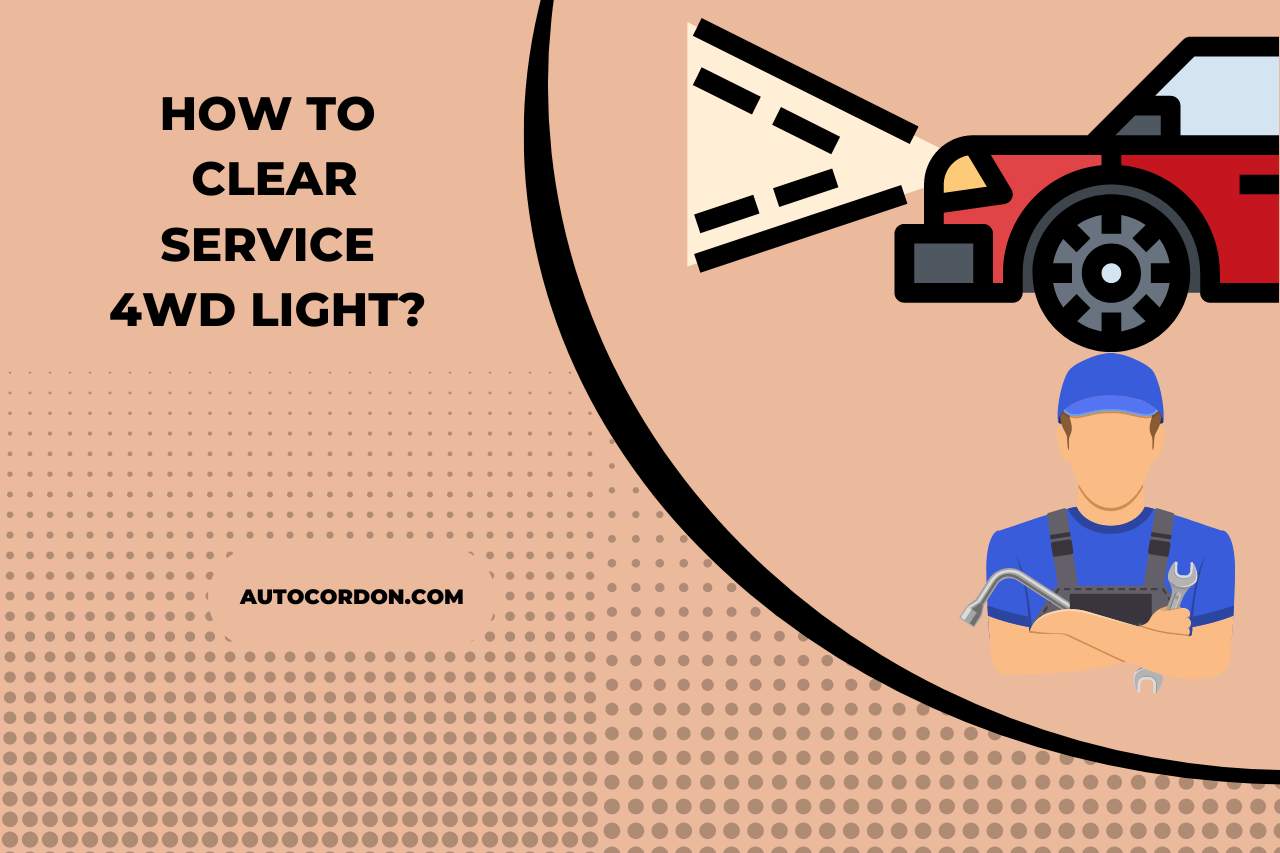How to Clear Service 4WD Light? Here’s What You Can Do!
A blinking Service 4WD light could have occasionally caught your attention if you drive a 4WD car or enjoy off-roading. Less competent drivers may find the experience unsettling, and for a good reason: Ignoring this warning light might result in major issues as well as damage to the car. Examining “how to clear service 4WD light” is the topic of this manual.
What the service 4WD light means, what it means, and why it comes on are all explained in this article. Discover how to prevent the Service of 4WD Lights in the future and how frequently and the price it costs for servicing 4WD.
What is Service 4WD Light?
Your Jeep is equipped with technology that makes even the roughest roads easier to drive on. To make the full potential from your Jeep, a 4WD service structure, also known as “Four Wheel Drive,” is always required.
But regrettably, there are a number of potential causes for system failure. And your Jeep’s display is illuminated by the 4WD caution light when a problem arises.
The words ‘SERV 4WD’ or ‘4WD’ are written on the instrument panel, but you cannot read them unless the light shines through them.
Problems with your Jeep’s critical systems, such as its 4WD structure, are not good for your Jeep.
What does Service 4WD Light Indicate?
Whenever the 4WD light comes on, it alerts you to a problem with the 4WD system that has to be fixed right away. An incorrect gearshift might also cause this light to come on.
This is perplexing, harmful to the motor, and might cause your 4WD maintenance light to glow nonstop.
Get to a qualified technician as quickly as you can if you think you have put the car in gear correctly, but the warning light continues to come on since it may be a transmission problem.
Constantly flashing a 4WD choice may occasionally be a sign of a system issue. Any motorist can find that obnoxious and inconvenient notification.
Why Is the Service 4WD Light On in My Vehicle?
Transfer Case that is not working properly or is too hot.
A broken down or overheated transmission case constitutes one of the most typical culprits. It might possibly jeopardize the complete 4WD system if it is broken or overused.
Wiring that has Been Damaged or Rusted
The repair light may also come on if the 4WD system’s wiring is damaged or rusted.
The 4WD system may operate irregularly or perhaps not at all if cables have been harmed, corroded, or broken, which may cause the maintenance light to come on.
Polluted or Low Fluid
The “Service 4WD” light may also come on if there are issues regarding the system’s electricity or sensors, worn-out or broken 4WD parts, damaged divergence axles, low or dirty levels of fluid in the transmission case or variations, worn-out or broken 4WD components, or any of these things.
Since these fluids are necessary for lubricating and cooling, low or dirty fluid levels might prevent the 4WD system from operating as intended.
How to Clear Service 4WD Light?
Examine the Service Light
Start by making sure the light is on. You can notice a light on your car’s display that says Serv 4wd and Service 4wd.
Remove the Knee Bolster and Dash Bezel
When you are certain that you must turn off the Service 4WD sunlight, remove the dash bezel as well as the knee bolster. The dash bezel has to be removed, which is the easiest task. It merely needs to be snapped out.
Turn the Switch Assembly by Pulling
The ignition switch assembly must first be taken out before the dashboard bezel and knee bolster can be removed.
Disassemble the Transfer Case Control Unit
The transferring case control unit will be visible once the switch’s component has been removed.
Then pay attention to both of the wires that connect to the small gray box. In this section, you need to unhook the cables. Once you’ve finished, start the vehicle and make sure the 4WD signal is still on.
Remove the Negative Cable from the Power Source
Find the battery and unplug the negative wire from it. The cable should then be left slack, and your car should then be allowed to rest for at least an hour. Begin your automobile after reconnecting the negative wire. Even if the preceding step doesn’t work, this will.

Is It Safe to Drive with the Service 4WD Light On?
You might be able to operate your car without encountering any significant problems, depending on what is causing the “service 4WD” light.
In some circumstances, however, driving while the warning light is on may result in expensive replacements and permanent damage.
The differential and transfer case may overheat and fail while you are driving, which might result in a serious accident.
Continued use of the vehicle while this light is on might harm the 4WD system considerably and need costly future repairs when one or more of the other parts stated above are not working properly.
You need to stop immediately away whenever the light comes on or arrange to have the car towed to a servicing facility.
How to Avoid Service 4WD Light in Future?
The repair 4WD light frequently does not signal that your car needs regular upkeep.
The light instead signals that there is a problem with the maintenance of the 4WD system. Therefore, you ought to examine it and have it rectified.
There are several interpretations of the service 4WD light. Thus, not all problems will have the same answer.
The best course of action is to do a specialized code check on the transferred Case Control Module plus apply specified patches.
Always seek the advice of an expert mechanic if you are unable to resolve maintenance 4WD light difficulties on your own.
It is preferable to make sure your truck is secure before starting it up with the dashboard light on.
How Much does It Cost to Service 4WD?
The price of 4WD maintenance varies by car type and maintenance provider. The cost of labor is another factor.
The treatment typically costs between $800 to $1300 on average. Additionally, every 30,000 miles is the recommended interval for 4WD service.
The price is totally based on the type of car you drive. Your four-wheeler’s kind will affect the method and the labor price. To find out more regarding the price, speak with a nearby expert.
How Often should you Service 4 Wheel Drive?
Frequent fluid checks are required, as well as frequent fluid replacements for differentials. Not exceeding 30–36,000 miles in certain circumstances. And in other circumstances, it may happen once every 15,000 miles.
While under it, be sure to check for any form of leaks as well. Regular fluid replacement is required. This indicates that there could have been 15,000 miles, but usually, there aren’t exceeding 36.
FAQ
Is 4WD service necessary?
Yes, 4WD service is necessary for maintaining the proper function and longevity of a four-wheel-drive system. Just like any other vehicle component, the 4WD system comprises multiple parts that are prone to wear and tear. Regular servicing ensures that all these parts, like the transfer case, differentials, and locking hubs, remain in optimal condition.
Failing to service a 4WD can lead to reduced performance, potential breakdowns, and costly repairs down the line. Therefore, to ensure safe operation and prevent unexpected issues, it’s advisable to follow the vehicle manufacturer’s recommended service intervals for your 4WD system.
Is 4WD expensive to maintain?
Yes, 4WD can be more expensive to maintain compared to two-wheel-drive (2WD) systems. The complexity of 4WD systems, which include additional components like transfer cases and front differentials, means there are more parts that require regular servicing and potential replacement.
Additionally, the robust nature of 4WD vehicles often encourages drivers to tackle rough terrains, which can expedite wear and tear. While the costs might be higher, maintaining a 4WD system is crucial for its performance, safety, and longevity. It’s essential to factor in these additional maintenance costs when considering owning a 4WD vehicle.
Does 4WD use more oil?
No, 4WD itself does not use more oil than 2WD. The amount of engine oil required is determined by the engine’s design and capacity, not the drivetrain configuration. However, 4WD systems have additional components, like transfer cases and potentially an extra differential, which require their own specific lubricants.
While a 4WD system doesn’t increase the engine’s oil consumption, owners might find themselves purchasing additional types of lubricants for the maintenance of these extra components. Regular checks and maintenance are essential to ensure the proper functioning of all vehicle systems.
Watch this one,
Video Credits – briansmobile1 Youtube Channel
You May Also Like

Madusha is a writer for Autocordon.com and a seasoned mechanic with a profound passion for all things automotive, particularly the intricate world of vehicle transmissions. With years of hands-on experience in the garage, Madusha’s expertise extends from routine maintenance to complex repair solutions. In the bustling auto repair community, Madusha is known not only for precision and skill but also for an enthusiast’s zeal for cars that transcends the workshop.



![How to Bypass Idle Shutdown? SOLVED!! [Causes & Fixes]](https://autocordon.com/wp-content/uploads/2023/02/how-to-bypass-idle-shutdown-768x512.jpg)




